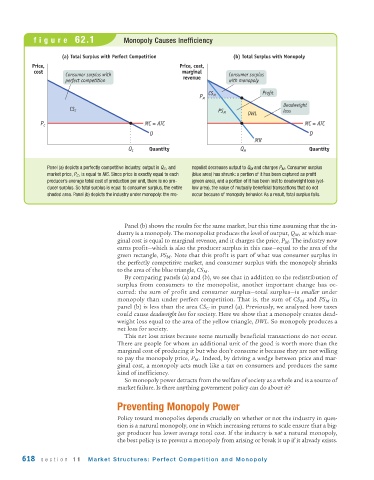Page 660 - Krugmans Economics for AP Text Book_Neat
P. 660
figure 62.1 Monopoly Causes Inefficiency
(a) Total Surplus with Perfect Competition (b) Total Surplus with Monopoly
Price, Price, cost,
cost marginal
Consumer surplus with Consumer surplus
perfect competition revenue with monopoly
Profit
CS M
P M
Deadweight
CS C loss
PS M
DWL
MC = ATC MC = ATC
P C
D D
MR
Quantity Quantity
Q C Q M
Panel (a) depicts a perfectly competitive industry: output is Q C , and nopolist decreases output to Q M and charges P M . Consumer surplus
market price, P C , is equal to MC. Since price is exactly equal to each (blue area) has shrunk: a portion of it has been captured as profit
producer’s average total cost of production per unit, there is no pro- (green area), and a portion of it has been lost to deadweight loss (yel-
ducer surplus. So total surplus is equal to consumer surplus, the entire low area), the value of mutually beneficial transactions that do not
shaded area. Panel (b) depicts the industry under monopoly: the mo- occur because of monopoly behavior. As a result, total surplus falls.
Panel (b) shows the results for the same market, but this time assuming that the in-
dustry is a monopoly. The monopolist produces the level of output, Q M , at which mar-
ginal cost is equal to marginal revenue, and it charges the price, P M . The industry now
earns profit—which is also the producer surplus in this case—equal to the area of the
green rectangle, PS M . Note that this profit is part of what was consumer surplus in
the perfectly competitive market, and consumer surplus with the monopoly shrinks
to the area of the blue triangle, CS M .
By comparing panels (a) and (b), we see that in addition to the redistribution of
surplus from consumers to the monopolist, another important change has oc-
curred: the sum of profit and consumer surplus—total surplus—is smaller under
monopoly than under perfect competition. That is, the sum of CS M and PS M in
panel (b) is less than the area CS C in panel (a). Previously, we analyzed how taxes
could cause deadweight loss for society. Here we show that a monopoly creates dead-
weight loss equal to the area of the yellow triangle, DWL. So monopoly produces a
net loss for society.
This net loss arises because some mutually beneficial transactions do not occur.
There are people for whom an additional unit of the good is worth more than the
marginal cost of producing it but who don’t consume it because they are not willing
to pay the monopoly price, P M . Indeed, by driving a wedge between price and mar-
ginal cost, a monopoly acts much like a tax on consumers and produces the same
kind of inefficiency.
So monopoly power detracts from the welfare of society as a whole and is a source of
market failure. Is there anything government policy can do about it?
Preventing Monopoly Power
Policy toward monopolies depends crucially on whether or not the industry in ques-
tion is a natural monopoly, one in which increasing returns to scale ensure that a big-
ger producer has lower average total cost. If the industry is not a natural monopoly,
the best policy is to prevent a monopoly from arising or break it up if it already exists.
618 section 11 Market Structures: Perfect Competition and Monopoly

